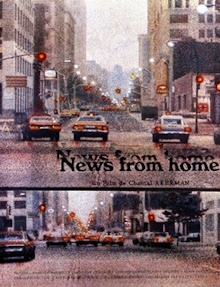Chantal Akerman’s reputation made a huge leap a couple of years ago when her Jeanne Dielman shot to the top of the polls of the greatest films of all time. As I’ve never seen any of her work, I thought I’d opt for a gentler introduction to her style with what is ostensibly a documentary about New York from the perspective of a Frenchwoman. It still isn’t an easy watch at all as there is no structure and the only dialogue is the reading of letters from the director’s home in France. I kind of just let both the images and the words of the letters wash over as there is nothing concrete to hold on to. It was fascinating see the New York of the era and emotions of the director’s mother comes through strongly, but I still had a hard time being fully engaged with it.
The entire film consists of imagery of the city of New York with no commentary apart from Akerman’s own voice reading the letters she has received from her mother. The camera is usually in a fixed position in order to capture whatever and whoever happens to enter the frame without focusing on anyone or anything in particular. In this way, the images show the streets of the city and the cars that pass by, the pedestrians on the sidewalks, the buildings and the signs on them and so on. Akerman also goes into the subway to show ordinary New Yorkers in the trains and on the platforms. The sound quality seems poor to me making it almost impossible to make out the spoken French without relying on subtitles. I’d have thought that this was due to picking up ambient sound without cleaning or mixing it, but I read that the sound was added later. The content of the letters never refer to the images, recounting instead news about Akerman’s family back in Belgium and asking after how she is doing in the United States.
It can be interesting to have these unfiltered views of faraway places and bygone times. I was surprised to note that the New York that is shown in these images seems way less busier than I’d imagined. Traffic flows smoothly, many of the streets are empty and there are none of the massive jams we’re used to seeing in Asia. The subway system never looks particularly packed and even a presumably busy station like Times Square only has moderate footfall. Less surprising but still notable is how grimy, dirty and worn down the city looks. The subway commuters walk by ignoring the litter on the ground. Every subway car has graffiti on it. So many of the buildings look run down or even abandoned. The New York of today is much richer than it was in the 1970s of course and probably Akerman wanted to show the specific places she hung around when she lived there as someone doing only petty jobs and so these are not the upmarket neighborhoods. Even so, the imagery neither flatters the city nor makes it look like an appealing place to live in.
In the context of this not-quite-a-documentary that works rather well. We neither see Akerman herself nor any part of her home in Brussels yet the New York that we see combined with the emotive appeals of Akerman’s mother in her letters, is enough to paint in our imagination an idyllic and welcoming place. We never get to read Akerman’s responses to her mother and there’s a sort of sameness to the contents of the letters after a while. Her mother pleads for Akerman to write her back, complains that she doesn’t tell her any details about her life in New York and worries about her, while providing small updates on how her family members and friends are doing. It’s the sort of parental concern familiar to us all over the world but it works well to give this film an emotional core and the images only exacerbate the sense of how distant from home she is and seemingly isolated.
That said, there’s only so much that I can get out of this film and it can be a struggle at times to keep from being bored. The images are brutally honest but not beautiful and the droning voice reading the letters gets repetitive. It is impressive how much Akerman can achieve with so little but that doesn’t keep me from wishing that this were a more substantial film.
